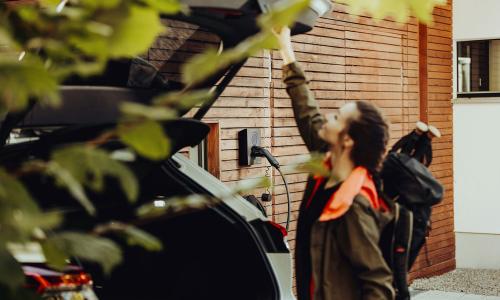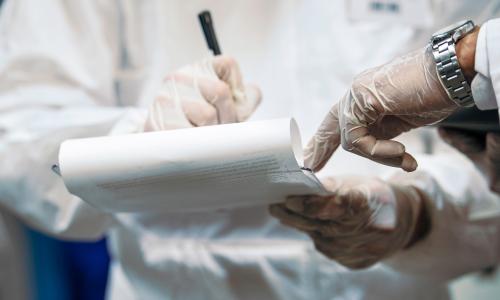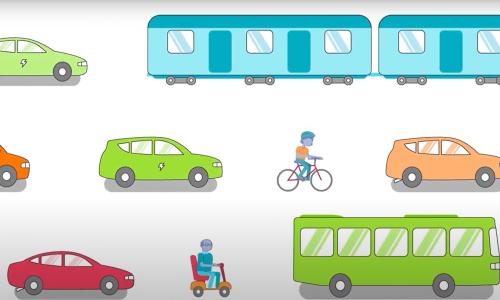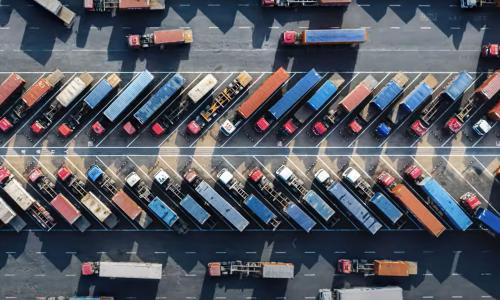Everyone needs to get from point A to point B, and Jess talks with urban planner and UCS Director of Clean Transportation Steven Higashide about the latest and greenest in what moves us.
Transcript
The 20th century was the age of the internal combustion engine, but changing times call for changes in how we live, work, and even move. Bigger populations and the effects of burning fossil fuels on a massive scale for most of the last two centuries means we need better solutions for how we get around. It's time to move.
I’m your host Jess Phoenix, and this is science.
JESS: Joining me today is Steven Higashide, director of the Clean Transportation program here at the Union of Concerned Scientists. Steven is an urban planner, and his work has long centered around policy that aims to improve transit across the country, with a particular emphasis on equity via reducing air pollution and emissions through applying scientific lessons. Since how we move impacts every single person in the U.S., this work couldn't be more relevant. So, thanks for taking the time to talk with me, Steven. And why don't you start by giving us a quick sketch of transportation challenges in the United States?
STEVEN: Oh, sure, Jess, really happy to be here. So, transportation is the largest contributor to greenhouse gas emissions in the U.S., 28% of emissions. And we have known, and UCS has done so much work on tackling that through electrifying the vehicles that run on our roadway networks, the cars and trucks people drive, the freight vehicles that are delivering packages to people's houses, and that is such an essential strategy. But it's also not the whole picture. We also have to look at the fact that the transportation system we have in a lot of ways really doesn't give people a lot of choices to get around, can make people feel as though they have to drive for every trip, maybe they need multiple cars in their household, and that has all kinds of impacts. It's very expensive. Transportation is the second-highest piece of household costs, kind of right behind housing. It's one of the reasons why we have one of the most energy-inefficient transportation systems among developed or wealthy countries. And it really exacerbates a lot of the inequality in U.S. society.
And so, we are at a moment where I think we can really start thinking about how do we rebalance the transportation system? How do we get away from this kind of cars first, very highway-dependent system into one where people actually have affordable, abundant, convenient choices, whether that is a bus and train service that's walkable from your house, whether those are safe pathways so you could use an e-bike to get around? We could plan our towns and cities in ways that things are a little closer together. And so, even if you are driving, maybe you're driving a little less. All of these would add up, not just to reduce climate emissions, but actually make life easier, more affordable, give people more opportunity.
JESS: I'd like to roll it back for a second because I think not a lot of folks take the time to understand how we got here. So, how has our transportation system in the U.S. evolved into one that entrenches poor health outcomes and difficult commutes for people from lower-income, more vulnerable communities? Like, how did all that happen?
STEVEN: You know, a lot of it goes back to the really significant role the federal government has played in building out the interstate highway system. And, you know, obviously, this did some things that you'd say are good. You know, it made it easier to get from city to city. It was in some ways, you know, safer than many of the roads that it was replacing, but the interstate highway system also tore through city after city and displaced millions of people, primarily Black people, people of color. And the impacts on those communities really kind of reverberate all the way to today because, you know, states will go back, widen the roads in those same places, and just compound impact after impact. You know, in kind of the public health world, we often talk about cumulative impacts, the idea that, you know, you can't just look at the public health-harming pollution from, say, a power plant or a highway in itself. You look at the fact that all of these things tend to be in the same communities. And when you look at the transportation system, you know, those highways are going through the same places that already are host to so many environmental injustices.
And while there have been federal investments in transit over the years, they just don't add up to this enormous sum that we have continued to spend on more and wider highways. You know, long after I think almost any expert would say that the system is complete, in fact, you know, in the late 20th century, the government actually declared the interstate highway system functionally complete, but we keep going back to cities, widening highways. In some places, there may be 10, 20-lane roads, and the federal policy, in a lot of ways, is doubling down on what is not working. And we need to do something different. We need to give people abundant transit, safe biking, and walking. And there are a lot of ways we can do that, whether that's at the state level, at the federal level, and, of course, at the local level. So, it's many decades of policy that have got us here, and we have the power to, you know, stop digging this hole.
JESS: What does not having good clean transit options, what does that do to individual people in terms of their health? Because I know that is one of the big driving reasons that we're re-examining a lot of transit options is that it's hurting people.
STEVEN: In transportation, we might think about how poor air quality impacts public health. But when you look at lack of transportation options, it's often more about what health experts call the social determinants of health. And those are things like, is it easy for you to get to what you need? Is it easy for you to get to the doctor's office? Is it easy for you to get to a job or education that's gonna give you good quality of life? Is it easy for you to see your friends and people in your community? And what happens when folks don't have those options is it's really a kind of social isolation, lack of opportunity that ends up having huge impacts on people's health in a number of different dimensions. And that's really true, not just in cities, but in rural areas, too. We often think about public transit as a city thing, right? But it's actually in many of these rural places where there tend to be a lot of older residents, a lot of low-income residents. It's having something as simple as a bus that runs every hour to a major city that's gonna connect you with the hospital you need, the stores you wanna visit, maybe family you have in that city. And without those options, it becomes really hard for people to age in place.
JESS: When we look at these solutions, you mentioned having more bus service available, but are there other transit solutions that can help out in rural areas?
STEVEN: I'm gonna start by actually coming back to the bus for a second because there are some places in the U.S. that are doing a good job of this. So, in Colorado, for example, in the last few years, they have started up this statewide bus service that they call Bustang. So, like Mustang, but a bus. And the bus actually has a picture of a horse on the side of it, very on-brand. And, I mean, it's just a coach bus running on major highways, connecting all kinds of communities to Denver, to Colorado Springs, to other cities, but passing through the very rural areas. And the ridership has just been exploding over the past several years. And I think it just helps show that in a lot of cases, we don't actually need some kind of super innovative, high-tech solution. We have a lot of solutions that can work for people if we have the planning and the funding. People are really clamoring for some solutions that are pretty simple to provide.
And then I think when we think about rural areas, rural can mean a lot of things. And one thing that it often means actually is really kind of classic main street towns that actually are pretty very logical places to serve with transit. They are population centers that people are trying to get to. They're places where if you had safe sidewalk networks, they could be places where maybe you drive, but you just park once and get everything you need to get done in that area. They are often places of natural beauty that folks might be trying to get to and having more transportation options is really helpful there. So, just to say that there's quite a diversity of rural areas, and the kinds of transportation options that folks need are gonna vary depending on what that place looks like.
JESS: I wanted to talk tech for a moment because I think most of our listeners at least are pretty familiar with electric vehicles. But can you tell me how much of an impact on pollution, climate change, and health outcomes going electric with our nation's cars and trucks and buses and freight vehicles, how big of an impact can that have?
STEVEN: Yeah, well, so earlier this year, the EPA finalized two rules that will really help clean up light-duty, light-duty meaning passenger cars and trucks, and heavy-duty meaning everything from tractor trailers to a number of kind of smaller trucks. And those rules don't require electrification, but combined through 2055, they're gonna result in 8.2 billion metric tons of reduction of greenhouse gas emissions, which makes them some of the most ambitious climate rules that have ever been passed in the history of the U.S. That's just to give you a sense of the magnitude and to say that if we can then go even further, if we can get to 100% electrification, it really is just a massively important piece of cleaning up transportation emissions. And we do believe that we have the technology to get to 100% in those sectors.
So, then I wanna note, okay, so where does giving people more transportation options fit in? Part of what it does is that it can make this transition to a 100% electric transportation system. It allows us to do it more quickly, more affordably because if you have 100% electric cars and trucks, but people don't need to drive as much, then, well, you don't need to build out the grid as much, to pick one example. You don't need to build as much electric distribution. And so, you're just giving yourself a mountain that is a little bit easier to climb, which is really important when we're talking about how quickly we need to achieve this transition.
There have been a lot of improvements to what in the transit industry, people talk about demand response service, which is basically the ability to make transit a little more like Lyft or Uber where you schedule a ride, something shows up, and it might be a shared vehicle. And that kind of transit is never gonna replace a subway or a busy bus, but in more rural and suburban areas, it can be a really convenient solution that is affordable both for members of the public and the public sector. And I think maybe the last thing I'll say on kind of new technology, you know, talk about electrifying vehicles, I think e-bikes have become just really exciting for folks as well. And something that a lot of households are finding actually can replace a car for a lot of trips, even to take your kids around, do grocery shopping. There's a New York Times columnist, Jamelle Bouie, who has an e-bike that he loves. He's always posting about it on his Instagram. And he's really replacing trips that, you know, his family would have needed another car for.
JESS: So, what are lower-tech ways that cities and towns can help reduce dependence on fossil fuel-based transportation?
STEVEN: I think a lot of this comes down to what you might call just basic town planning. Like, can you build a kind of main street community where it's easy and convenient to walk to what you need? Are you building housing near the public transportation systems that you have? In a lot of ways, these are solutions that really cost almost no money, but have huge impacts. And I think you kind of see in so many cities, whether it's cities like New York, but even places like Houston, Austin, Indianapolis, local leaders everywhere are just really embracing biking, walking, and public transportation. And I think that one of the kind of other issues that then points to is, are state governments helping, or are they getting in the way? That's really one of the keys to whether a region has been able to transform its transportation system.
JESS: What are the costs of staying hooked into our current system from a financial perspective? I mean, I know there are people out there who love their internal combustion engine cars. So, what is our incentive to switch from our wallets’ perspective?
STEVEN: If you just look at what the public sector spends on transportation infrastructure. So, where do our federal tax dollars go? Where do our state tax dollars go? We're spending tens of billions of dollars every year on a system that mostly puts it into maintaining and expanding highways. And we're getting very little benefit from that at this point. We know that when you widen the road within a few years, typically, the traffic just comes back. It's something that transportation engineers call induced demand. And if we were spending that money instead on giving people other options, we would make it easier for families to get to school, for young people to get better jobs, for older people to age in place. The effects would just kind of ripple throughout society. And then that's not even accounting for the personal costs, the fact that owning a private vehicle comes with many thousands of dollars a year in upkeep. And we've created a situation where a lot of families feel like they have to have two or even three cars. It's a really crushing burden.
JESS: I wanted to know if you have any other success stories for us about places where they have made changes to how people get around and what those stories are.
STEVEN: One of the places in the U.S. that I think is one of the most important success stories is the Seattle region, where in the early 2000s, both the public and local and regional leaders really made the decision to heavily invest in public transit. And there's now this very extensive light rail system with kind of new stations opening every few years. In fact, there were two big pieces of it that opened earlier this year. Not only that, members of the public have voted again and again, I mean, to increase their own taxes to expand bus service, to fix up sidewalks and make it safer to walk around, to build out this regional rail system, and to build tens of thousands of units of new housing close to those transit stations so that people can live there, people can access these options. And as a result, Seattle has grown and grown and grown, but driving hasn't. They're doing this thing where they are growing without traffic.
And in fact, Washington state as a whole is a place where people are driving less. And it's one of only a few states where that is happening. And it just kind of shows that the story of having good transportation options, it's not something that only happens over in London, or in Tokyo, or Mexico City, or all these places that folks in the U.S. might go on vacation and then talk about, "Oh, it's so great. You could take the train there. We can walk around. Why can't we do it here?" It's like we actually are doing it here. And Seattle is a place where we're really doing it and people are really using it. And it's a place where the state government, to get back to something I said earlier, is actually really supportive, and for a long time has had programs to, for example, really incentivize people to commute to their workplaces using non-automobile options. So, it's a place where the local policy and the state policy are really working together and it's been transformational.
JESS: Are there any spots around the country that are a little bit more, I would guess, yeah, conservative, maybe more from red states that are doing this work? STEVEN: Indianapolis, which is a place I mentioned before, has been successful in building some bus rapid transit. And when you look at the folks who were advocating for that, it was this coalition that spans the business community, all the way to the faith community and social justice groups. There was really a consensus that that is what the city needed to keep growing its economy. I think in a lot of ways, giving people more transportation options is very uncontroversial at the local level. When you talk to average people, when you talk to, say, city council member, I think it's really a no-brainer. And it has only been at the federal level that it has become more polarized and has been kind of brought into the culture war in a way that's really unfortunate because it's just about giving people options, it's just about giving people some freedom to choose how we get from one place to another.
JESS: My last question on This Is Science, is a two-part question, and I ask everybody this. So, as you well know, we're the Union of Concerned Scientists. So, Steven, why are you concerned?
STEVEN: Oh, why am I concerned? Wow. Well, I think that a lot of parents would probably say this. So, my son is about to turn 3 years old. And, of course, I'm just constantly thinking about the kind of world that he is going to inherit. When we do our work in the Clean Transportation program, and we're kind of planning out, "Okay, what are we gonna work on? What are our goals?" We're often talking about, "Okay, what do we need by 2030? What do we need by 2035? What do we need by this date?" And it's like, "All right, what is it gonna mean when he's in high school? What is it gonna mean when he is kind of stepping into the workforce?" And, of course, it's not just about him, it's about everyone. And it is just about like, "What are we leaving for? And what are we doing for the communities around us?" I think that when I work on transportation, we often talk about, say, mode choice. How are we gonna choose to get to this place? Am I gonna pick my car? Am I gonna pick public transit? Am I gonna pick my bike? But transportation is important, not because of those individual choices, but because of what it means for our communities. And whether we can build the cities, the rural areas, the regions, where people have what they need to get ahead in life and have a good quality of life, have safety, have public health, it's all about building the community that we want. And so, that concern is always on my mind.
JESS: Okay. So, I do wanna wrap up on a high note. So, what are you doing about that concern?
STEVEN: Oh, well, wow. We have a really exciting slate of analyses coming out over the next year, by which I mean, like, the folks on the Clean Transportation team are just diving in and helping us understand so many different aspects of the kind of transportation system we need. Whether that is more transportation choices, we have work looking at why we need to recycle electric vehicle batteries. We have work looking at how EVs could connect to the grid and help people power their homes, make communities more resilient. We're looking at progress in cleaning up the freight sector. When I look around at the Clean Transportation program, the folks on that team, the kind of analysis that we are doing is just so essential to policymakers. And it's gonna make a difference. We don't know what's gonna happen with politics, right? But we know that the work that we put out either is gonna help us advance the vision of a Clean Transportation system, make even more progress, or it's gonna be really important in defending what we have. And so, being a part of this solutions-oriented team is something that really inspires me. I joined the Clean Transportation team just about a year and a half ago. And I think the folks around me are really at the forefront of cleaning up transportation in this country. It's really an inspiring group of folks.
Thanks to Steven Higashide for making time to share his expertise. Thanks also to Omari Spears and Abby Figueroa for production help.
Arrivederci, scientistas!



